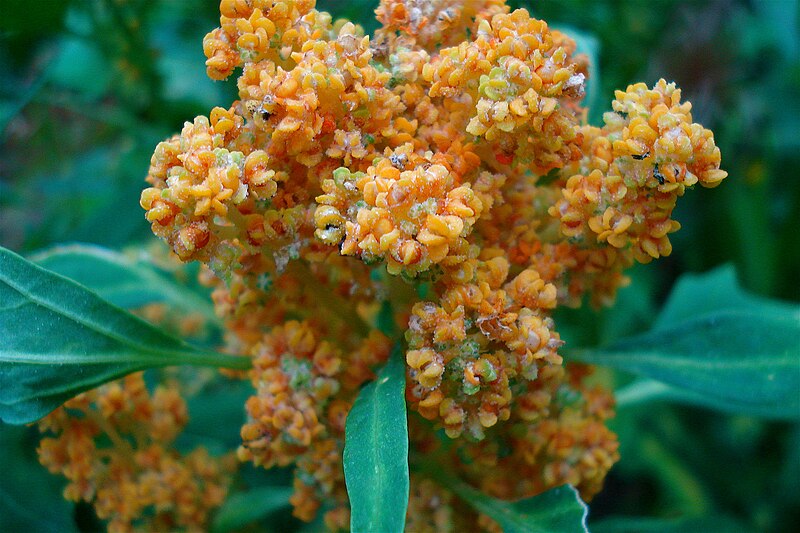 |
| Quinoa in flower image via Wikipedia |
And I don't often eat quinoa (pronounced keen-wah). Not that I don't like it, I do. And it's not that I'm unaware of its high protein content and that it contains a complete set of amino acids. We just don't generally buy it, and get our amino acids and protein in other foods.
And one of the reasons for not eating it frequently is the hype that surrounds it. Nutritional studies are notoriously bad, suffering from such problems as lack of controls, poor sample sizes, and the way potential monetization can drive results. I recently finished reading Fear of food : a history of why we worry about what we eat by Harvey A Levenstein, which kind of put all these studies into perspective.
I'm going to quote the jacket copy, because it really does sum up this book quite well.
Food is one of those places where the rules have broken down. Lies are told, marketing drives what is available with progressively smaller niche markets being created (did we really need chocolate-like flavoured rice krispies?), and we have marketing driving food faddism. Like quinoa.There may be no greater source of anxiety for Americans today than the question of what to eat and drink. Are eggs the perfect protein, or are they cholesterol bombs? Is red wine good for my heart or bad for my liver? Will pesticides, additives, and processed foods kill me? Here with some very rare and very welcome advice is food historian Harvey Levenstein: Stop worrying!In Fear of Food Levenstein reveals the people and interests who have created and exploited these worries, causing an extraordinary number of Americans to allow fear to trump pleasure in dictating their food choices. He tells of the prominent scientists who first warned about deadly germs and poisons in foods, and their successors who charged that processing foods robs them of life-giving vitamins and minerals. These include Nobel Prize–winner Eli Metchnikoff, who advised that yogurt would enable people to live to be 140 by killing the life-threatening germs in their intestines, and Elmer McCollum, the “discoverer” of vitamins, who tailored his warnings about vitamin deficiencies to suit the food producers who funded him. Levenstein also highlights how large food companies have taken advantage of these concerns by marketing their products to combat the fear of the moment. Such examples include the co-opting of the “natural foods” movement, which grew out of the belief that inhabitants of a remote Himalayan Shangri-la enjoyed remarkable health and longevity by avoiding the very kinds of processed food these corporations produced, and the physiologist Ancel Keys, originator of the Mediterranean Diet, who provided the basis for a powerful coalition of scientists, doctors, food producers, and others to convince Americans that high-fat foods were deadly.In Fear of Food, Levenstein offers a much-needed voice of reason; he expertly questions these stories of constantly changing advice to reveal that there are no hard-and-fast facts when it comes to eating. With this book, he hopes to free us from the fears that cloud so many of our food choices and allow us to finally rediscover the joys of eating something just because it tastes good.
Quinoa has become so popular in the developed world (primarily Europe and North America) that the entire crop is now being sold for export. Quinoa has trebled in price since 2006. In Lima, Peru, quinoa costs more per kilo than chicken (approx. 10 soles per kilo for quinoa against 7.8 soles per kilo for chicken).
With prices so high, domestic quinoa consumption has dropped by at least a third, and that consumption has been replaced with low-quality high-calorie imports of processed food from the global north. The problem is that quinoa has always been a staple in Bolivia and Peru. The campaign to reduce infant malnutrition in Peru, lead by their First Lady Nadine Heredia, relies on quinoa. But the fad for quinoa in the developed world means that quinoa has become much more difficult to provide to children. Our consumption of quinoa here is driving poverty and malnutrition there.
In the modern neo-liberal trading regime, dollars acquired in the North trump malnutrition concerns in the South. This kind of colonial exploitation has been going on forever, of course. The United Fruit Company had the US Marines sent in to ensure the banana harvest would maintain its profitability (leading to the phrase "banana republic"). But that doesn't make it right.

No comments:
Post a Comment